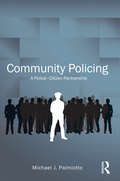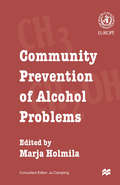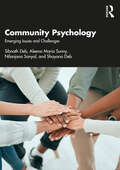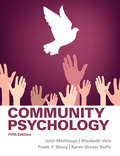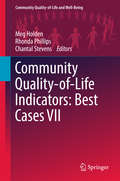- Table View
- List View
Community Policing: A Police-Citizen Partnership (Criminology and Justice Studies)
by Michael J. PalmiottoThis textbook discusses the role of community-oriented policing, including the police image, public expectations, ethics in law enforcement, community wellness, civilian review boards, and what the community can do to help decrease crime rates. In addition, the author covers basic interpersonal skills and how these might vary according to the race, sex, age, and socioeconomic group with which the officer is interacting. Finally, students learn how to initiate new programs in a community, from the planning process and community involvement to dealing with management and evaluating program success.
Community Policing: A Police-Citizen Partnership (Criminology and Justice Studies)
by Michael J. PalmiottoThis textbook discusses the role of community-oriented policing, including the police image, public expectations, ethics in law enforcement, community wellness, civilian review boards, and what the community can do to help decrease crime rates. In addition, the author covers basic interpersonal skills and how these might vary according to the race, sex, age, and socioeconomic group with which the officer is interacting. Finally, students learn how to initiate new programs in a community, from the planning process and community involvement to dealing with management and evaluating program success.
Community Policing in America (Criminology and Justice Studies)
by Jeremy M. WilsonAlthough law enforcement officials have long recognized the need to cooperate with the communities they serve, recent efforts to enhance performance and maximize resources have resulted in a more strategic approach to collaboration among police, local governments, and community members. The goal of these so-called "community policing" initiatives is to prevent neighborhood crime, reduce the fear of crime, and enhance the quality of life in communities. Despite the growing national interest in and support for community policing, the factors that influence an effective implementation have been largely unexplored. Drawing on data from nearly every major U.S. municipal police force, Community Policing in America is the first comprehensive study to examine how the organizational context and structure of police organizations impact the implementation of community policing. Jeremy Wilson’s book offers a unique theoretical framework within which to consider community policing, and identifies key internal and external factors that can facilitate or impede this process, including community characteristics, geographical region, police chief turnover, and structural complexity and control. It also provides a simple tool that practitioners, policymakers, and researchers can use to measure community policing in specific police organizations.
Community Policing in America (Criminology and Justice Studies)
by Jeremy M. WilsonAlthough law enforcement officials have long recognized the need to cooperate with the communities they serve, recent efforts to enhance performance and maximize resources have resulted in a more strategic approach to collaboration among police, local governments, and community members. The goal of these so-called "community policing" initiatives is to prevent neighborhood crime, reduce the fear of crime, and enhance the quality of life in communities. Despite the growing national interest in and support for community policing, the factors that influence an effective implementation have been largely unexplored. Drawing on data from nearly every major U.S. municipal police force, Community Policing in America is the first comprehensive study to examine how the organizational context and structure of police organizations impact the implementation of community policing. Jeremy Wilson’s book offers a unique theoretical framework within which to consider community policing, and identifies key internal and external factors that can facilitate or impede this process, including community characteristics, geographical region, police chief turnover, and structural complexity and control. It also provides a simple tool that practitioners, policymakers, and researchers can use to measure community policing in specific police organizations.
Community Power and Empowerment (Advances in Community Psychology)
by Brian D. ChristensMany people want to help bring about changes in their neighborhoods, workplaces, and communities. Leaders and scholars of change efforts are likewise eager for insights into what makes some organizations and coalitions capable of building and exercising power. Why are some groups successful in making changes in policies and systems and in sustaining their momentum over time, while others struggle or never really get off the ground? With Community Power and Empowerment, Brian D. Christens brings the most comprehensive analysis of empowerment theory yet conducted to bear on these questions, taking aim at many of the longstanding weaknesses and ambiguities of empowerment theory, research, and practice. For example, one major hindrance is that most notions of empowerment have not been coherently connected with community power. In addition, research has emphasized psychological aspects of empowerment over organizational processes, and has neglected community empowerment processes to an even greater extent. By linking empowerment and community power, Christens constructs a holistic framework for assessing and comparing community-driven change efforts. This book offers new guidance for inquiries into outcomes and impacts of empowerment processes on health and well-being, providing a resource for researchers, organizational leaders, practitioners, and anyone interested in collective action for change.
Community Power and Empowerment (Advances in Community Psychology)
by Brian D. ChristensMany people want to help bring about changes in their neighborhoods, workplaces, and communities. Leaders and scholars of change efforts are likewise eager for insights into what makes some organizations and coalitions capable of building and exercising power. Why are some groups successful in making changes in policies and systems and in sustaining their momentum over time, while others struggle or never really get off the ground? With Community Power and Empowerment, Brian D. Christens brings the most comprehensive analysis of empowerment theory yet conducted to bear on these questions, taking aim at many of the longstanding weaknesses and ambiguities of empowerment theory, research, and practice. For example, one major hindrance is that most notions of empowerment have not been coherently connected with community power. In addition, research has emphasized psychological aspects of empowerment over organizational processes, and has neglected community empowerment processes to an even greater extent. By linking empowerment and community power, Christens constructs a holistic framework for assessing and comparing community-driven change efforts. This book offers new guidance for inquiries into outcomes and impacts of empowerment processes on health and well-being, providing a resource for researchers, organizational leaders, practitioners, and anyone interested in collective action for change.
Community Practice and Urban Youth: Social Justice Service-Learning and Civic Engagement
by Melvin DelgadoCommunity Practice and Urban Youth is for graduate level students in fields that offer youth studies and community practice courses. Practitioners in these fields, too, will find the book particularly useful in furthering the integration of social justice as a conceptual and philosophical foundation. The use of food, environmental justice, and immigrant-rights and the book’s focus on service-learning and civic engagement involving these three topics offers an innovative approach for courses.
Community Practice and Urban Youth: Social Justice Service-Learning and Civic Engagement (Social Justice Youth Community Practice Ser.)
by Melvin DelgadoCommunity Practice and Urban Youth is for graduate level students in fields that offer youth studies and community practice courses. Practitioners in these fields, too, will find the book particularly useful in furthering the integration of social justice as a conceptual and philosophical foundation. The use of food, environmental justice, and immigrant-rights and the book’s focus on service-learning and civic engagement involving these three topics offers an innovative approach for courses.
Community Prevention of Alcohol Problems
by Marja HolmilaThis book is an action research study of a community at work. The community prevention project set the system in motion, revealing its character and internal dynamics. This process and its context are analyzed from a sociological point of view. It is shown that the type of community prevention that really works and creates sustainable changes, is neither value neutral nor given from above: it adheres to reason, rituals and emotions alike, and requires subjective involvement of the people in the community.
Community Prevention of Child Labor: Evidence-based Practices to Promote the Psychological Well-being of Minors (Human Well-Being Research and Policy Making)
by Isidro Maya JariegoThis book discusses preventive actions that have led to reduction in the prevalence of child labor across the world over the 21st century. It identifies exemplary programs in the area of community prevention that have had exceptional results; for example, the involvement of children in hazardous work globally being reduced by half. It documents a wide range of contexts where concerted action has counteracted social permissiveness towards child labor, including psycho-educational interventions in preventing early school leaving and conditional cash benefits which counteract family poverty. The book presents a set of evidence-based practices that are particularly useful for psychologists, educators, and social workers. More broadly, this book is also of interest to policymakers, professionals, and activists involved in child protection policy or in implementing programs to promote the psychological well-being of children.
Community Psychology: Emerging Issues and Challenges
by Sibnath Deb Aleena Maria Sunny Nilanjana Sanyal Shayana DebThis book focuses on the theoretical concepts of community psychology and its applications in day-to-day life. It discusses the challenges that adversely affect the welfare and well-being of common people and suggests community-centric, evidence-based measures to address them. Factors like new-age lifestyles, fast-paced development, and an increase in occurrence of natural calamities have been detrimental to the psychological well-being of the community. This volume integrates the social, cultural, economic, political, and environmental aspects of community psychology to address community life-based issues which include mental health stigma, social asymmetries, resource disparities, disadvantaged minority groups, the differently abled, HIV/AIDS patients, project-affected people, and disaster victims. Key features of this book include: • Dedicated intervention-based chapters on mental health, physical health, differently abled people, the elderly, vulnerable children, HIV/AIDS patients, and people affected by development projects and disasters. • Focus on challenges faced by students and school-based family counselling. • Case studies and conceptual models for better understanding and application of the subject. The volume will be a valuable resource to students, researchers, and teachers of Psychology, Social Work, Sociology, Public Health, and Social Economics. It will also be an indispensable read for social workers, NGOs, advocacy groups, and policymakers working in the field of social upliftment.
Community Psychology: Emerging Issues and Challenges
by Sibnath Deb Aleena Maria Sunny Nilanjana Sanyal Shayana DebThis book focuses on the theoretical concepts of community psychology and its applications in day-to-day life. It discusses the challenges that adversely affect the welfare and well-being of common people and suggests community-centric, evidence-based measures to address them. Factors like new-age lifestyles, fast-paced development, and an increase in occurrence of natural calamities have been detrimental to the psychological well-being of the community. This volume integrates the social, cultural, economic, political, and environmental aspects of community psychology to address community life-based issues which include mental health stigma, social asymmetries, resource disparities, disadvantaged minority groups, the differently abled, HIV/AIDS patients, project-affected people, and disaster victims. Key features of this book include: • Dedicated intervention-based chapters on mental health, physical health, differently abled people, the elderly, vulnerable children, HIV/AIDS patients, and people affected by development projects and disasters. • Focus on challenges faced by students and school-based family counselling. • Case studies and conceptual models for better understanding and application of the subject. The volume will be a valuable resource to students, researchers, and teachers of Psychology, Social Work, Sociology, Public Health, and Social Economics. It will also be an indispensable read for social workers, NGOs, advocacy groups, and policymakers working in the field of social upliftment.
Community Psychology: Fifth Edition
by Karen Grover Duffy Frank Y Wong Elizabeth Vera John MoritsuguCommunity Psychology, 5/e focuses on the prevention of problems, the promotion of well-being, empowerment of members within a community, the appreciation of diversity, and an ecological model for the understanding of human behavior. Attention is paid to both “classic” early writings and the most recent journal articles and reviews by today’s practitioners and researchers. Historical and alternative methods of effecting social change are explored in this book, with the overall theme that the environment is as important as the individual in it.This text is available in a variety of formats – digital and print. Learning Goals Upon completing this book, readers will be able to: Understand the historical and contemporary principles of community psychology. Apply theory and research to social services, mental health, health, legal, and public health systems
Community Psychology: Fifth Edition (Mysearchlab Series 15% Off Ser.)
by Karen Grover Duffy Frank Y Wong Elizabeth Vera John MoritsuguCommunity Psychology, 5/e focuses on the prevention of problems, the promotion of well-being, empowerment of members within a community, the appreciation of diversity, and an ecological model for the understanding of human behavior. Attention is paid to both “classic” early writings and the most recent journal articles and reviews by today’s practitioners and researchers. Historical and alternative methods of effecting social change are explored in this book, with the overall theme that the environment is as important as the individual in it.This text is available in a variety of formats – digital and print. Learning Goals Upon completing this book, readers will be able to: Understand the historical and contemporary principles of community psychology. Apply theory and research to social services, mental health, health, legal, and public health systems
Community Psychology
by John Moritsugu Elizabeth Vera Frank Y Wong Karen Grover DuffyCommunity Psychology, 6th Edition offers an easy-to-navigate, clearly organized, and comprehensive overview of the field, with theoretical roots that carry over to practical applications. Presenting the concepts of community psychology and social change, these concepts are then applied to various systems addressing the human condition: mental health, medical, public health, school, legal, and industrial/organizational. Through a unique three-part approach, including concepts, interventions, and applications of the theory, the book opens the field of community psychology to students who are interested in how psychology might help themselves and the systems around them. It then focuses on the prevention of problems, the promotion of well-being, the empowerment of members within a community, the appreciation of diversity, and an ecological model for the understanding of human behavior. Attention is paid to both "classic" early writings and the most recent journal articles and reviews by today’s practitioners and researchers. Historical and alternative methods of effecting social change are explored in this book, with the overall theme that the environment is as important as the individual in it. This 6th edition will include new topical subjects such as grit and life success, changes in technology and their impact, interventions based on networking, social movements and justice, dealing with stigma, and new models of health. It will appeal to advanced undergraduates as well as graduates taking courses on community psychology, social psychology, clinical psychology, and related fields.
Community Psychology
by John Moritsugu Elizabeth Vera Frank Y Wong Karen Grover DuffyCommunity Psychology, 6th Edition offers an easy-to-navigate, clearly organized, and comprehensive overview of the field, with theoretical roots that carry over to practical applications. Presenting the concepts of community psychology and social change, these concepts are then applied to various systems addressing the human condition: mental health, medical, public health, school, legal, and industrial/organizational. Through a unique three-part approach, including concepts, interventions, and applications of the theory, the book opens the field of community psychology to students who are interested in how psychology might help themselves and the systems around them. It then focuses on the prevention of problems, the promotion of well-being, the empowerment of members within a community, the appreciation of diversity, and an ecological model for the understanding of human behavior. Attention is paid to both "classic" early writings and the most recent journal articles and reviews by today’s practitioners and researchers. Historical and alternative methods of effecting social change are explored in this book, with the overall theme that the environment is as important as the individual in it. This 6th edition will include new topical subjects such as grit and life success, changes in technology and their impact, interventions based on networking, social movements and justice, dealing with stigma, and new models of health. It will appeal to advanced undergraduates as well as graduates taking courses on community psychology, social psychology, clinical psychology, and related fields.
Community Psychology: In Pursuit of Liberation and Well-being
by Nelson, Geoffrey; Prilleltensky, IsaacIn its broadest sense, community psychology studies the individual's relationships to their community and to wider society. Sitting at the junction between social and clinical psychology, and heavily influenced by activist traditions in political science, sociology and social work, this powerfully written book delivers a comprehensive introduction to the definition and aims of this justice-orientated field of psychology. Editors Nelson and Prilleltensky cover a broad range of the critical perspectives and fundamental values that define the aims of community psychology, highlighting the psychosocial praxis that these have produced and the key political and societal ills that they aim to prevent. Written with a global perspective, this book exhibits internationally authored chapters as well as in-text commentators and cross-cultural case studies. This book is a key guide to understanding how community psychologists function to resolve structural injustice and bring about transformative change to the socio-economic issues of our time such as homelessness, mental health, racism, discrimination and marginalisation. This text can be used as an essential guide for undergraduate students beginning courses in Community Psychology as it presents a thorough history of the field, a rigorous breakdown of the various socio-economic issues at the heart of community psychology’s focus, as well as a critical analysis of methods of intervention and research.
Community Psychology: In Pursuit of Liberation and Well-Being
by Isaac Prilleltensky Geoffrey Nelson Stephanie Reich Manuel Riemer Scotney EvansThe second edition of this introductory textbook, Community Psychology, has been updated and expanded to reflect how changes within society have led to developments across the field.The authors offer a fascinating introduction for students, setting out the principles of community psychology as they consider how its roots have helped to shape the goals of liberation and well-being. Following this, the authors look closely at the conceptual, interventional and research tools of community psychology and how they can be applied in different contexts, the difficulties faced and practical ways to help achieve social justice.Featuring a wide range of critical perspectives, international examples, exercises and additional online resources, this textbook will encourage students to think more critically about the role of psychology in society and about how community psychology can aid in the liberation of oppressed groups to promote social justice and well-being.
Community Psychology and the Socio-economics of Mental Distress: International Perspectives
by Carl Walker Liz Cunningham Katherine JohnsonProviding unique global perspectives on community psychology, this is exciting and important reading for students and researchers alike, written by leading experts in the field. Drawing on a wealth of experience and examples, it offers an essential guide to the political global context of this fast-developing area of psychology.
Community Quality-of-Life Indicators: Best Cases (Social Indicators Research Series #22)
by Dong-Jin Lee, Don Rahtz, M. Joseph SirgyThis book is a compilation of cases of best work in community indicators research. The cases describe communities that have launched their own community indicators programs. Elements that are included in the descriptions are the history of the community indicators work within the target region, the planning of community indicators, the actual indicators that were selected, the data collection process, the reporting of the results, and the use of the indicators to guide community development decisions and public policy. Community planners, community indicators researchers and urban planning specialists will find this book very helpful in learning from communities that have done community indicators work and have done it well.
Community Quality-of-Life Indicators: Best Cases VII (Community Quality-of-Life and Well-Being)
by Meg Holden Rhonda Phillips Chantal StevensThis book is the seventh volume in a series covering best practices in community quality of life indicators. The case studies and analysis in this volume demonstrate how community indicators projects today operate within a need to amplify the voice of disadvantaged communities, seriously explore the increasing use of information technology, produce positive community change and sustain these efforts over time. The work presented here spans North American and Australian community work and demonstrates how the field of community indicators has undergone a rapid evolution in only a few decades. Today as in their original formulations, community indicators projects are designed to gauge the social, economic and physical health and well-being of communities.
Community Quality-of-Life Indicators: Best Cases VIII (Community Quality-of-Life and Well-Being)
by Frank Ridzi Chantal Stevens Melanie DavernThis book offers critical insights into the thriving international field of community indicators, incorporating the experiences of government leaders, philanthropic professionals, community planners and a wide range of academic disciplines. It illuminates the important role of community indicators in diverse settings and the rationale for the development and implementation of these innovative projects. This book details many of the practical “how to” aspects of the field as well as lessons learned from implementing indicators in practice. The case studies included here also demonstrate how, using a variety of data applications, leaders of today are monitoring and measuring progress and communities are empowered to make sustainable improvements in their wellbeing. With examples related to the environment, economy, planning, community engagement and health, among others, this book epitomizes the constant innovation, collaborative partnerships and the consummate interdisciplinarity of the community indicators field of today.
Community Quality-of-Life Indicators: Best Cases IX (Community Quality-of-Life and Well-Being)
by Frank Ridzi Chantal Stevens Lyle WrayThis volume continues the tradition now established since 2006, of compiling excellent research into the practice and application of community indicators in a single source volume. It focuses on the theme of the Community Indicators Consortium 2020 Summit, as a significant venue for the advancement of the practice and theory of community indicators work. It covers the conference's theme of “community resilience”, which is the capacity of all of a community’s elements to survive, adapt, and grow no matter what kinds of chronic stresses and acute shocks they experience. In keeping with the practical, “best cases” emphasis of this book series, the editors incorporate a case-based approach to chapters discussing how specific indicators, indices or series of indicators can lead to better decisions and outcomes to help communities adapt and transform in the face of challenges, helping them prepare for both the expected and the unexpected to sustain and improve quality of life, including technology and open source approaches to data sharing and data-focussed collaboration; evolving approaches that use shared indicators to improve overall community well-being and quality of life; research related to community indicators and policy, application, research, and/or practice; and techniques and approaches to measure resilience. This volume is of interest to social scientists, management professionals, social workers and policy makers working on various aspects of community indicators of quality of life and well-being. Chapter “The Cost of Sea Level Rise for the Island Community of Vinalhaven, Maine: Spurring action through collaborative data analysis” is licensed under the terms of the Creative Commons Attribution 4.0 International License (http://creativecommons.org/licenses/by/4.0/). For further details see licence information in the chapters.
Community Quality-of-Life Indicators: A Guide for Community Indicators Projects (Community Quality-of-Life and Well-Being)
by M. Joseph SirgyThis training book is designed to help professionals enhance their knowledge of community quality-of-life indicators, and to develop viable community projects. Chapter 1 describes the theoretical concepts that guide the formulation of community indicator projects. Chapter 2 creates a sample community indicator project as a template of the entire process. Chapter 3 describes the planning process: how to identify sponsors, secure funding, develop an organizational structure, select a quality-of-life model, select indicators, and so on. Chapter 4 focuses on data collection. Finally, Chapter 5 describes efforts related to dissemination and promotion of community indicators projects. Written by a stalwart in the field of quality-of-life research, this book provides the tools of sound community project planning for quality-of-life researchers, social workers, social marketers, community research organizations, and policy-makers.

